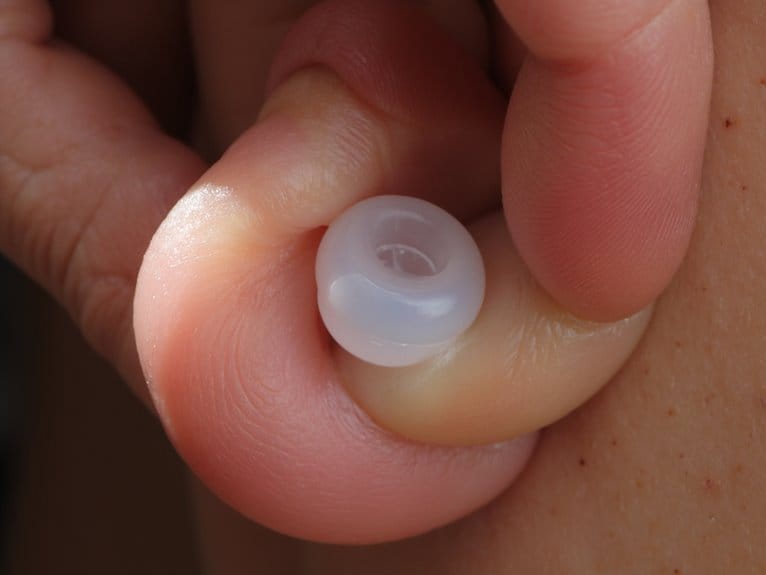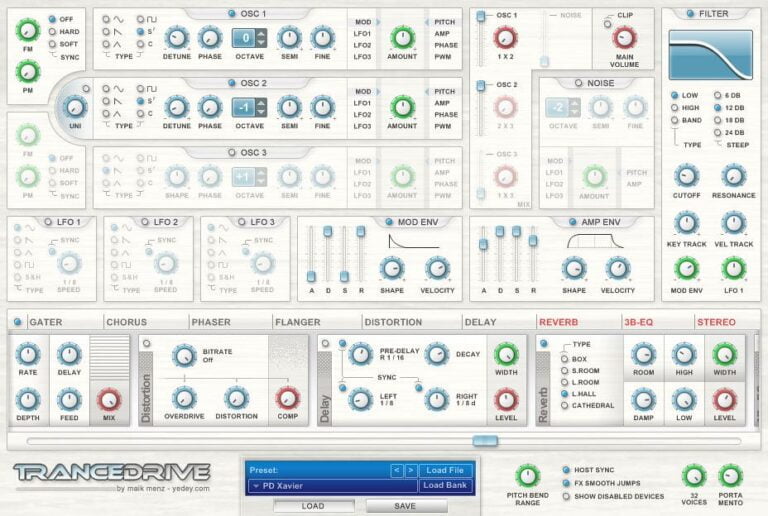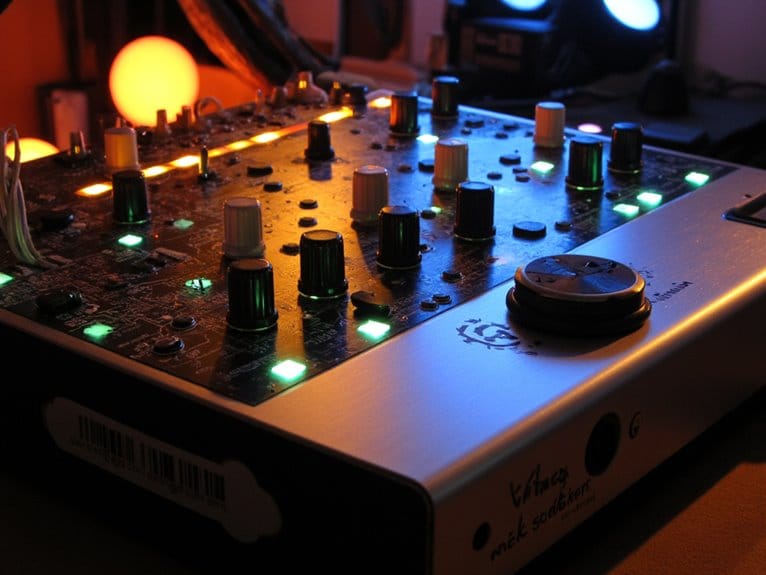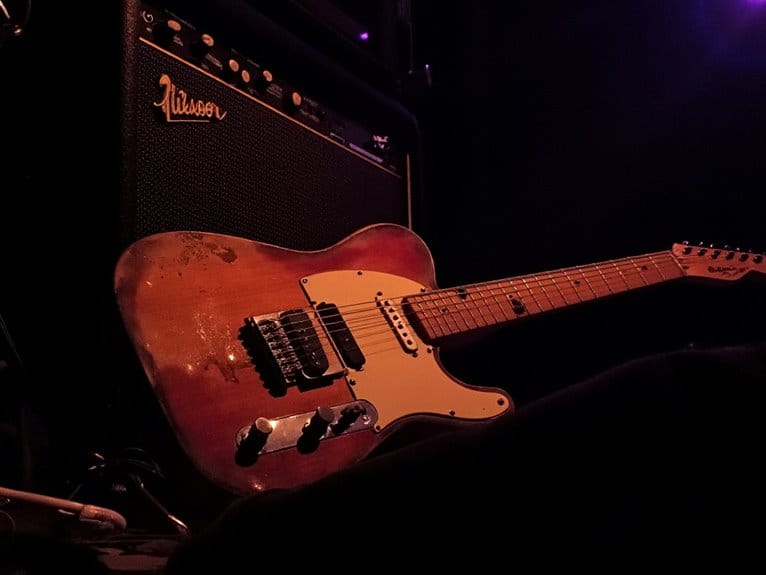In-Ear Monitor Fit and Comfort: Getting the Right Seal
You’ll achieve ideal in-ear monitor performance by mastering seal creation through proper ear tip selection and insertion technique. Start by testing multiple silicone or memory foam tip sizes, since ear canals vary greatly in shape and diameter. Gently pull your ear upward while inserting at a slight angle, creating the sealed chamber that delivers up to 38dB noise isolation and prevents bass frequency leakage. Proper fit balances sound quality with comfort, avoiding listener fatigue during extended sessions while maximizing clarity and isolation that transforms your audio experience into something remarkably more immersive.
We are supported by our audience. When you purchase through links on our site, we may earn an affiliate commission, at no extra cost for you. Learn more.
Notable Insights
- Pull your ear upward and insert the monitor at a slight angle to straighten the ear canal and achieve proper seal.
- Test multiple ear tip sizes and materials since ear canals vary greatly in shape and size between individuals.
- Choose between silicone tips for durability and easy cleaning or memory foam tips for superior noise isolation and comfort.
- Insert slowly to avoid air compression and discomfort while ensuring the ear tip creates a stable, sealed fit.
- A proper seal enhances bass response and provides 35-38dB noise isolation while preventing low frequency sound leakage.
Why Proper Seal Matters for Sound Quality and Isolation
When you slip in-ear monitors into your ears, you’re fundamentally creating a tiny sealed chamber that determines whether you’ll experience the rich, full sound your earphones were designed to deliver, or a thin, disappointing audio experience that leaves you wondering why you spent good money on quality gear.
The seal impact on your audio extends far beyond simple volume-it’s the difference between hearing every nuanced bass note around 50 Hz versus losing those frequencies entirely to leakage. A simple re-insertion of earpiece usually resolves most seal problems and restores the optimal fit needed for proper audio performance.
Without proper sealing, sound clarity suffers dramatically as low frequencies escape, leaving you with unbalanced, tinny audio that completely undermines your earphones’ capabilities while simultaneously allowing ambient noise to infiltrate your listening space. Quality in-ear monitors should provide 35dB+ noise isolation to effectively block external sound and maintain the integrity of your audio experience. The difference in audio quality is comparable to listening in a small room versus an open space where sound dissipates freely. Multiple ear tip sizes help achieve the secure and stable fit necessary for creating this optimal seal.
Essential Insertion Techniques for Optimal Fit
The proper insertion technique can transform your in-ear monitor experience from a frustrating struggle with loose-fitting earpieces to a seamless, comfortable seal that delivers the audio performance you’re paying for.
Understanding your ear canal anatomy is essential, as each person’s natural curves require personalized insertion strategies that work with, rather than against, your physiology.
I’ve found that gently pulling your ear upward while inserting at a slight angle following your canal’s natural path creates the most effective seal.
Insert slowly to avoid air compression, then release your ear to let it return to its natural shape, which locks the IEM in place.
This methodical approach prevents discomfort while maximizing both sound isolation and bass response through proper positioning. Professional-grade IEMs can provide up to 38 dB of noise isolation when properly fitted, which is crucial for protecting your hearing during live performances.
Individual anatomy impacts performance significantly, making ear tip selection crucial for achieving the optimal fit that transforms muddy stage sound into surgical precision.
Choosing the Right Ear Tip Size and Material
Perfect insertion technique won’t save you from poor audio performance if you’re using the wrong ear tips, and I’ve watched countless audiophiles blame their expensive IEMs when the real culprit was something as simple as choosing medium tips when they needed large ones.
Understanding ear tip materials becomes essential since silicone offers durability and easy cleaning, while memory foam provides superior noise isolation through expansion.
Your comfort preferences will determine whether you need liquid silicone’s ultra-soft flexibility for extended sessions or hybrid tips that balance isolation with comfort.
I recommend testing multiple sizes since ear canals vary dramatically-too large causes discomfort, too small kills bass response and seal quality, ultimately compromising your entire listening experience.
Professional IEMs typically include multiple silicone or foam ear tips in various sizes, and proper ear tip fit affects both sound quality and seal performance significantly during extended performances.
Balancing Acoustic Performance With Listening Comfort
Although achieving perfect acoustic performance might seem like the ultimate goal, I’ve learned through years of testing that prioritizing sound quality at the expense of comfort creates an impossible listening experience that defeats the entire purpose of premium IEMs.
You’ll find that the most successful monitors achieve acoustic balance through natural sound reproduction, which actually reduces listener fatigue rather than increasing it.
Technologies like Air Pressure Exchange systems help maintain sound isolation while alleviating the ear pressure that typically builds during extended sessions.
Memory foam tips and custom-fit designs enhance both comfort and acoustic performance simultaneously, proving these elements aren’t mutually exclusive.
The key lies in finding monitors with balanced sound signatures that deliver clear highs and controlled lows without forcing you to endure physical discomfort.
Troubleshooting Common Fit Problems and Solutions
When fit problems arise with your IEMs, I’ve found that systematic troubleshooting saves both time and frustration, since most issues stem from just a handful of common causes that you can identify and resolve without professional help.
Start by testing different ear tip sizes and materials, as incorrect sizing compromises both seal and comfort regardless of your ear anatomy.
I always check cable connections first, since loose connectors often masquerade as fit-related channel imbalances.
Try the upward ear pull technique during insertion, which straightens your ear canal for better placement.
If foam tips don’t work, switch to silicone variants, and confirm you’re using matching tips on both sides.
These simple fit adjustments resolve most problems I encounter.
Frequently Asked Questions
How Often Should I Replace Foam Ear Tips for Optimal Hygiene?
You should replace foam ear tips every three months for ideal ear hygiene practices. Replace sooner if they’re visibly dirty or damaged. Proper foam tip lifespan depends on your usage frequency and individual earwax production levels.
Can I Use IEMS While Exercising Without Losing the Seal?
You can maintain seal during exercise with sport-specific IEMs featuring sweat resistance and enhanced earphone stability. Use proper tip sizing, over-ear cable routing, and soft silicone materials to prevent slippage during movement.
Are Custom-Molded Ear Tips Worth the Extra Cost for Casual Listeners?
For casual listeners, custom earphones aren’t worth the extra cost unless you’re experiencing fit issues or need superior sound isolation. Well-fitted universal tips usually provide adequate comfort and performance for intermittent use.
Do Certain Ear Canal Shapes Work Better With Specific IEM Brands?
Yes, certain ear canal shapes do work better with specific IEM brands. You’ll find brands like Zeitgeist Germany offer different sizes, while custom brands like Empire Ears accommodate unique shapes perfectly.
On a final note
You’ve now got the knowledge to transform those uncomfortable, poor-sounding earbuds into precision instruments that’ll stay put and deliver the audio quality you’re paying for. Remember, finding the perfect fit isn’t just about comfort-though your ears will thank you during those marathon listening sessions-it’s about unleashing the full potential of your in-ear monitors and getting every dollar’s worth of performance you deserve.







